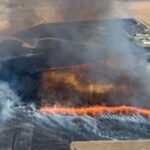Tenerife Wildfires Lead to Evacuation of Villages
Summary
A major wildfire has occurred on the Spanish island of Tenerife, resulting in the evacuation of five villages. The fire started in a nature reserve on Tuesday evening and has since spread across 8 sq km (800 hectares). The local authorities have closed off access to the forest around Mount Teide, Spain’s highest peak. Helicopters have been deployed to spray water over the affected areas, but the steep terrain has made it difficult for firefighters to control the blaze. Secondary fires have also broken out, exacerbating the situation. The villages of Arrate, Chivisaya, Media Montaña, Ajafoña, and Las Lagunetas have been evacuated. The recent heatwave in the Canary Islands and global climate change have increased the risk of wildfires in the region.
Analysis
The Tenerife wildfires come as no surprise in the context of this summer’s global wildfire season. Wildfires have been devastating various parts of the world, including southern Europe, northern Africa, Canada, and Hawaii. Climate change has played a significant role in intensifying heatwaves, making them more frequent and longer-lasting. With temperatures rising worldwide, the risk of wildfires is expected to increase further unless urgent action is taken to reduce greenhouse gas emissions.
The Canary Islands, along with other regions affected by the recent heatwaves, are facing heightened wildfire risks due to the dry conditions. The lack of rainfall and high temperatures create the perfect conditions for fires to spread and become more difficult to control. Local authorities must be prepared to deploy firefighting resources promptly and efficiently to mitigate the damage caused by wildfires.
The evacuation of five villages highlights the immediate threat to residents posed by such fires. It is essential that adequate emergency protocols and evacuation plans are in place and regularly reviewed to ensure the safety of vulnerable communities. Additionally, public awareness campaigns on wildfire prevention and preparedness can contribute to minimizing the risk of ignition and improving overall response to future wildfire events.
Opinion
The Tenerife wildfires serve as a stark reminder of the urgent need to address climate change. The devastating consequences of wildfires, from the displacement of communities to the destruction of ecosystems, underscore the importance of global efforts to reduce greenhouse gas emissions and transition to sustainable practices.
Governments around the world must prioritize climate action and make significant cuts to emissions to prevent further escalation of the climate crisis. Investments in renewable energy, sustainable land management, and reforestation programs are crucial steps toward mitigating the impacts of climate change and reducing the risk of wildfires.
It is also essential to recognize the interdependence of ecosystems and human activities. Forest management practices, such as controlled burns and strategic clearings, can help mitigate future wildfires. However, these measures must be based on scientific research and take into account the delicate balance of ecosystems. Collaborative efforts involving scientists, policymakers, and local communities are crucial to developing effective strategies that protect both human communities and the natural environment.
Advice
In regions prone to wildfires, individuals can take personal measures to minimize their risk and contribute to overall prevention efforts. It is vital to adhere to local fire safety guidelines, including proper disposal of cigarette butts and other flammable materials. Creating defensible space around homes by clearing vegetation and maintaining a safe perimeter can also reduce the risk of property damage.
Community engagement is essential in building resilience against wildfires. Supporting local fire departments and emergency services through donations and volunteering can make a significant difference in their firefighting capabilities. Participating in community forums and advocacy groups focused on climate change and wildfire prevention can also help raise awareness and push for necessary policy changes.
Ultimately, addressing the increasing threat of wildfires requires coordinated action at all levels, from individuals to governments and international organizations. By implementing comprehensive strategies that prioritize climate action, sustainable land management, and community engagement, the world can work toward minimizing the devastating impact of wildfires and mitigating the effects of climate change.

<< photo by Benjamin Lizardo >>
The image is for illustrative purposes only and does not depict the actual situation.
You might want to read !
- The Clash of Nations: Spain vs. England – A Rundown of the Match
- A-level Results Day 2023: Unveiling the Timely Release of Grades
- A-level Results Day 2023: The Time of Grade Release and Everything You Need to Know
- Heatwave Crisis on La Palma: Thousands Displaced from Their Homes
- “Foreign Office Issues Travel Warning as Storm Sparks Chaos in Spain and Portugal”
- “Foreign Office warns travelers of Storm Gloria’s impact on Spain and Portugal”
- “Bargain Bonanza: Wilko’s Administration Sale Slashes Prices, Leaving Thousands of Deals up for Grabs”
- Eruptions of Mount Etna Cause Temporary Closure of Sicilian Airport
- Erupting Mount Etna Disrupts Air Travel in Italy
- Shrewsbury Flower Show Evacuated Amid Security Threat: Exploring the Impact and Response
- The Blaze Engulfs Hawaii: Biden’s Major Disaster Declaration Unveils the Stark Reality
- “The Heartbreak of Dwayne Johnson and Jason Momoa: Maui’s Fate in Jeopardy”
- Editorial Exploration: Evaluating Jack Harrison’s Potential Impact at Everton
Title: “Examining Jack Harrison’s Impending Everton Loan: Strengths, Challenges, and Potential Contributions”
- Uncovering the Fate of Heart of Stone: A Potential Sequel in the Works?




